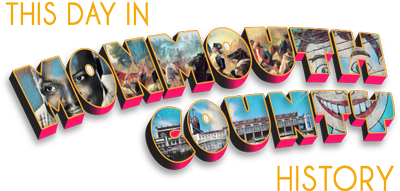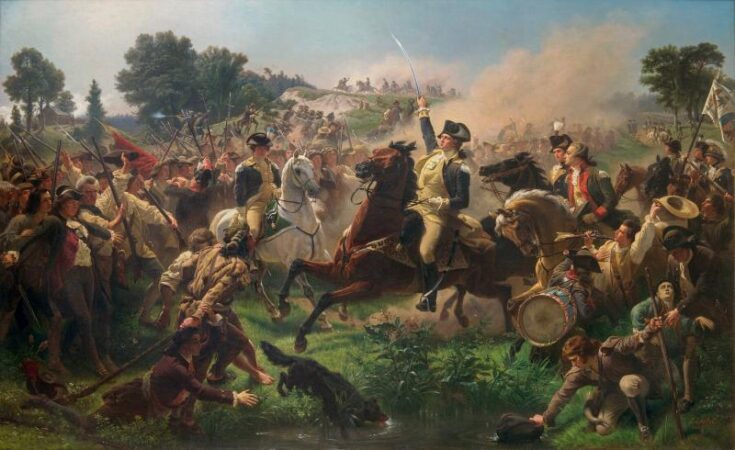Editor’s note: The following is adapted from the Battle of Monmouth Fact Sheet published by the Friends of the Monmouth Battlefield.
On Sunday, June 28, 1778, an American army of about 14,500, including about 1,000 militia, engaged a British army of about 21,000, including 4,100 Hessians (German mercenaries) and 2,100 Loyalists (Americans loyal to the British crown) in the longest one-day battle of the Revolutionary War, the Battle of Monmouth.
Staged in and around Freehold, then called Monmouth Court House, the Americans were led by General George Washington, 46, while the British were commanded by Lieutenant General Sir Henry Clinton, 48.
The British had captured what was then the American capital of Philadelphia in the fall of 1777. They stayed there that winter while the Americans spent the winter nearby in huts at Valley Forge. In early 1778, the British learned that the French were coming to help the Americans, so they decided to withdraw from Philadelphia and go back to their main base in New York City. They sent some of their troops by sea but did not have enough boats, so about 20,000 British troops would have to march across New Jersey to safe haven on Sandy Hook, and from there, board boats to New York.
The British left Philadelphia on June 18 and marched through Mount Holly and Bordentown. They reached Monmouth Court House on June 26 and stopped for a day to rest.
Loyalists took advantage of the opportunity to exact revenge on Freehold Patriots, identifying their homes, and after plundering them, setting them ablaze. These barbaric acts became known as “The Sack of Monmouth Court House,” and while this behavior was reprehensible to Clinton and his Hessian generals, they took no measures to stop it.
The Combatants
On the Patriot side, Major General Charles Lee, 47, led the American advance wing (no relation to Confederate General Robert E. Lee); Brigadier General “Mad Anthony” Wayne, 43, actively led a Continental Army brigade; Major General Friedrich von Steuben, 48, was a Prussian volunteer officer who retrained the American troops at Valley Forge; and Marquis de Lafayette, 21, was a French volunteer officer who led a Patriot division. For the British, Lieutenant General Charles Cornwallis, 40, led a British division. He later commanded the British army that surrendered at Yorktown in 1781.
The Battle
The British began to leave Monmouth Court House on the morning of June 28. When their rear guard was attacked by the American advance force east of Monmouth Court House, Clinton sent Cornwallis’s division back to face them. Lee’s American troops were forced to retreat to the west of Freehold, where they met Washington’s main force near Tennent. The fresh troops stopped the British advance around noon. After a long midday cannonade the two sides sparred with each other in the late afternoon but neither side could gain an advantage. The weather was extremely hot and humid, over 90 degrees. A large number of soldiers on both sides got sick and some even died from heat prostration and lack of water. The British pulled their lines back late in the day. That night they resumed their march to Sandy Hook.
The battle was technically a draw. Neither side was able to outfight the other. The British claimed a victory because they defeated Lee’s advance force and stopped the Americans from attacking their long column of wagons and supplies. The Americans claimed victory because they occupied the battlefield after the British left. This greatly increased American morale and strengthened Washington’s position as commander of the army.
Monmouth was the biggest and longest one-day battle of the war. The two sides did not engage in any large battles in the north after Monmouth. The Continentals were encouraged that the new drill and discipline they learned from General von Steuben enabled them to hold their own against veteran British troops in open battle.
General Washington reported 69 Patriot men died, 161 wounded, and 132 missing, total loss: 362. British numbers are uncertain but were approximately 67 killed in action, 59 died of fatigue, 170 wounded, and 65 missing, total: 361.
Sources:
Battle of Monmouth Fact Sheet. (2021). Historical Information on the Battle of Monmouth. Friends of the Monmouth Battlefield. Available: http://friendsofmonmouth.org/historical.html
Martin, Joseph Plum. (1962). Private Yankee Doodle. Little, New York, 1962.
Lender, Mark E., & Stone, Garry W. (2016). Fatal Sunday. University of Oklahoma Press, Norman, Okla.
Morrissey, Brendan. (2004). Monmouth Court House 1778. Osprey Books, Oxford, United Kingdom, 2004.
Smith, Samuel S. (1964). The Battle of Monmouth. Philip Freneau Press, Monmouth Beach, N.J., 1964.
Stryker William. (1927). The Battle of Monmouth. Princeton University Press, Princeton, N.J., 1927.
Featured image: Washington Rallying the Troops at Monmouth by Emanuel Gottlieb Leutze. Monmouth County Historical Association, used with permission. Available: https://monmouthhistory.emuseum.com/objects/626/washington-rallying-the-troops-at-monmouth?ctx=2f0b72412b8412db06bdb569d08b9b271050ea3d&idx=0


Leave a Reply